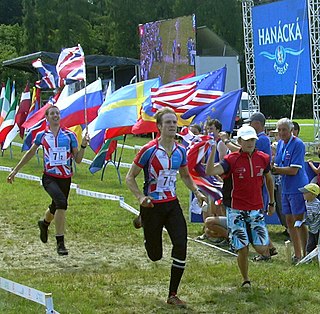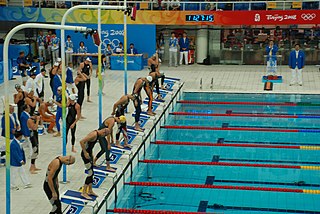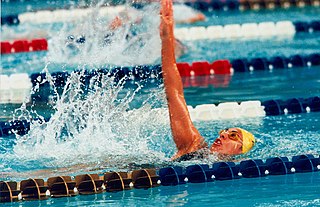Related Research Articles

A relay race is a racing competition where members of a team take turns completing parts of racecourse or performing a certain action. Relay races take the form of professional races and amateur games. Relay races are common in running, orienteering, swimming, cross-country skiing, biathlon, or ice skating. In the Olympic Games, there are several types of relay races that are part of track and field, each consisting of a set number of stages (legs), each leg run by different members of a team. The runner finishing one leg is usually required to pass the next runner a stick-like object known as a "baton" while both are running in a marked exchange zone. In most relays, team members cover equal distances: Olympic events for both men and women are the 400-metre and 1,600-metre relays. Some non-Olympic relays are held at distances of 800 m, 3,200 m, and 6,000 m. In the less frequently run medley relays, however, the athletes cover different distances in a prescribed order—as in a sprint medley of 200, 200, 400, 800 metres or a distance medley of 1,200, 400, 800, 1,600 metres.

The butterfly is a swimming stroke swum on the chest, with both arms moving symmetrically, accompanied by the butterfly kick along with the movement of the hips and chest. It is the newest swimming style swum in competition, first swum in the early 1930s and originating out of the breaststroke.

Breaststroke is a swimming style in which the swimmer is on their chest and the torso does not rotate. It is the most popular recreational style due to the swimmer's head being out of the water a large portion of the time, and that it can be swum comfortably at slow speeds. In most swimming classes, beginners learn either the breaststroke or the freestyle first. However, at the competitive level, swimming breaststroke at speed requires endurance and strength comparable to other strokes. Some people refer to breaststroke as the "frog" stroke, as the arms and legs move somewhat like a frog swimming in the water. The stroke itself is the slowest of any competitive strokes and is thought to be the oldest of all swimming strokes.

Backstroke or back crawl is one of the four swimming styles used in competitive events regulated by FINA, and the only one of these styles swum on the back. This swimming style has the advantage of easy breathing, but the disadvantage of swimmers not being able to see where they are going. It also has a different start from the other three competition swimming styles. The swimming style is similar to an upside down front crawl or freestyle. Both backstroke and front crawl are long-axis strokes. In individual medley backstroke is the second style swum; in the medley relay it is the first style swum.
Human swimming typically consists of repeating a specific body motion or swimming stroke to propel the body forward. There are many kinds of strokes, each defining a different swimming style or crawl.

Medley swimming is a combination of four different swimming strokes into one race. This race is either swum by one swimmer as individual medley (IM) or by four swimmers as a medley relay.

Swimming has been a sport at every modern Summer Olympics. It has been open to women since 1912. At the Olympics, swimming has the second-highest number of medal-contested events.
Misty Dawn Marie Hyman is an American former competition swimmer, Olympic gold medalist, and former world record-holder. Hyman won the gold medal in the women's 200-meter butterfly at the 2000 Summer Olympics in Sydney.

David "Dave" Charles Berkoff is an American former competition Hall of Fame swimmer, Olympic champion, and former world record-holder in two events. Berkoff was a backstroke specialist who won a total of four medals during his career at the Olympic Games in 1988 and 1992. He is best known for breaking the world record for the 100-meter backstroke three times, beginning at the 1988 Olympic trial preliminaries, becoming the first swimmer to go under 55 seconds for the event. He is also remembered for his powerful underwater backstroke start, the eponymous "Berkoff Blastoff" which after a strong push-off from the side of the pool used a horizontal body position with locked arms outstretched overhead and an undulating or wavelike aerodynamic dolphin kick to provide thrust and build speed.
Streamline form is a swimming technique that is used underwater in every stroke. At the start of a race or on a turn, streamline form is used, usually along with a dolphin kick or flutter kick, to create the least amount of resistance to help the swimmer propel as far as they can. Many factors contribute to the perfect streamline form and mastering this method increases a swimmer's speed. Streamline is one of the key fundamentals to mastering any stroke.

The dolphin kick is a kicking movement used in swimming. It is frequently used by competitive swimmers during entry and turns, and as part of the Butterfly stroke.

Swimming is an individual or team racing sport that requires the use of one's entire body to move through water. The sport takes place in pools or open water. Competitive swimming is one of the most popular Olympic sports, with varied distance events in butterfly, backstroke, breaststroke, freestyle, and individual medley. In addition to these individual events, four swimmers can take part in either a freestyle or medley relay. A medley relay consists of four swimmers who will each swim a different stroke, ordered as backstroke, breaststroke, butterfly and freestyle.

The front crawl or forward crawl, also known as the Australian crawl or American crawl, is a swimming stroke usually regarded as the fastest of the four front primary strokes. As such, the front crawl stroke is almost universally used during a freestyle swimming competition, and hence freestyle is used metonymically for the front crawl. It is one of two long axis strokes, the other one being the backstroke. Unlike the backstroke, the breaststroke, and the butterfly stroke, the front crawl is not regulated by the FINA. Hence, in "freestyle" competitive swimming events, any stroke or combination of strokes is permissible. This style is sometimes referred to as the Australian crawl although this can sometimes refer to a more specific variant of front crawl.

Freestyle is a category of swimming competition, defined by the rules of World Aquatics, in which competitors are subject to only a few limited restrictions on their swimming stroke. Freestyle races are the most common of all swimming competitions, with distances beginning with 50 meters and reaching 1,500 meters, also known as the mile. The term 'freestyle stroke' is sometimes used as a synonym for 'front crawl', as front crawl is the fastest surface swimming stroke. It is now the most common stroke used in freestyle competitions.

Swimming has been recorded since prehistoric times; the earliest recording of swimming dates back to Stone Age paintings from around 7,000 years ago. In 1578, Nikolaus Wynmann, a German professor of languages, wrote the first swimming book.
The men's 4 × 100 metre medley relay event at the 1960 Olympic Games took place on August 27 (qualification) and September 1 (final). This swimming event used medley swimming as a relay. Because an Olympic size swimming pool is 50 metres long, each of the four swimmers completed two lengths of the pool, each using a different stroke. The first on each team used the backstroke, the second used the breaststroke, the third used the butterfly stroke, and the final swimmer used freestyle.

The swimming competitions at the 2012 Summer Olympics in London took place from 28 July to 4 August at the Aquatics Centre. The open-water competition took place from 9 to 10 August in Hyde Park.

S8, SB7, SM8 are para-swimming classifications used for categorizing swimmers based on their level of disability. This class includes a number of different disabilities including people with amputations and cerebral palsy. The classification is governed by the International Paralympic Committee, and competes at the Paralympic Games.
The mixed 4 × 100 metre medley relay event at the 2020 Summer Olympics was held in 2021 at the Tokyo Aquatics Centre. These Games marked the first time to feature a mixed-gender swimming event in the program. Each 4-person team features two male and two female swimmers in no particular order.
Katherine Cadwallader Douglass is an American competitive swimmer and graduate student in mathematics. A versatile swimmer who competes in many events, Douglass won her first major international medal at the 2020 Olympic Games and then won three medals at the 2022 World Championships. Douglass then won six medals, including two golds, at the 2023 World Championships. At the 2024 World Championships, she won five medals, including two golds. Douglass won four medals, including two golds, at the 2024 Olympic Games; she became the Olympic champion in the 200 m breaststroke.
References
- 1 2 3 4 5 6 Collard, Luc; Auvray, Emmanuel; Bellaunay, Ivan (November 10, 2008). "Why have swimmers neglected the "fish kick" technique?". International Journal of Performance Analysis in Sport. 8 (3): 18–26. doi:10.1080/24748668.2008.11868444. ISSN 2474-8668. S2CID 148736089.
- 1 2 Shockman, Elizabeth (August 21, 2016). "The physics behind the world's fastest swim strokes". pri.org.
- 1 2 3 Penaluna, Regan (June 25, 2015). "Is This New Swim Stroke the Fastest Yet?". Nautilus. Retrieved September 30, 2020.
- 1 2 3 4 5 Miller, Matt (August 9, 2016). "The Fish Kick Is the Fastest Way for Humans to Swim. Why Aren't More Olympians Using It?". Slate Magazine. Retrieved September 30, 2020.
- 1 2 3 DeSimone, Bonnie (August 5, 1997). "This Stroke of Genius is Controversial". The Chicago Tribune. Retrieved March 21, 2021.
- ↑ "Michael Phelps' Final London 2012 Race - Men's 4 x 100m Medley | London 2012 Olympic Games". YouTube . August 4, 2012.